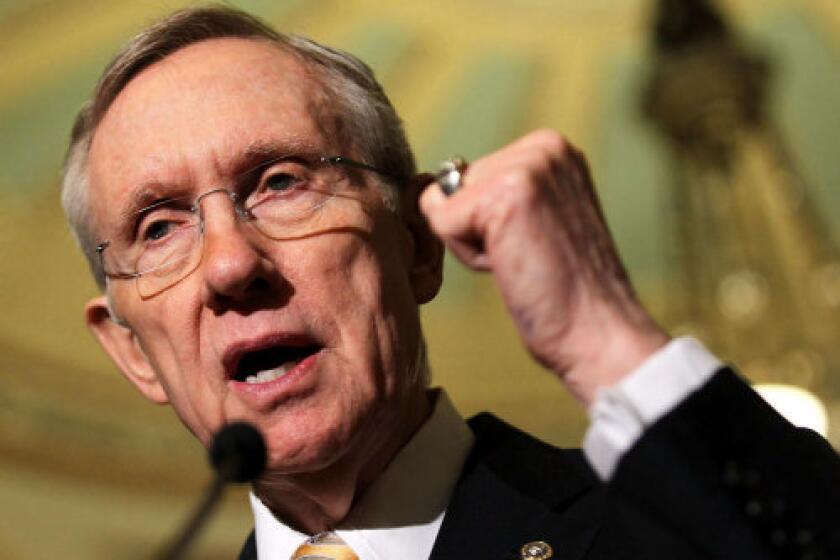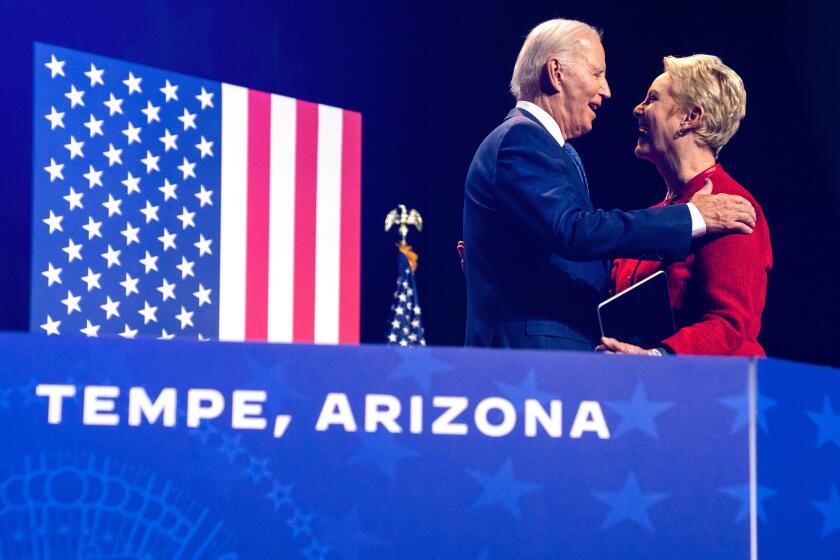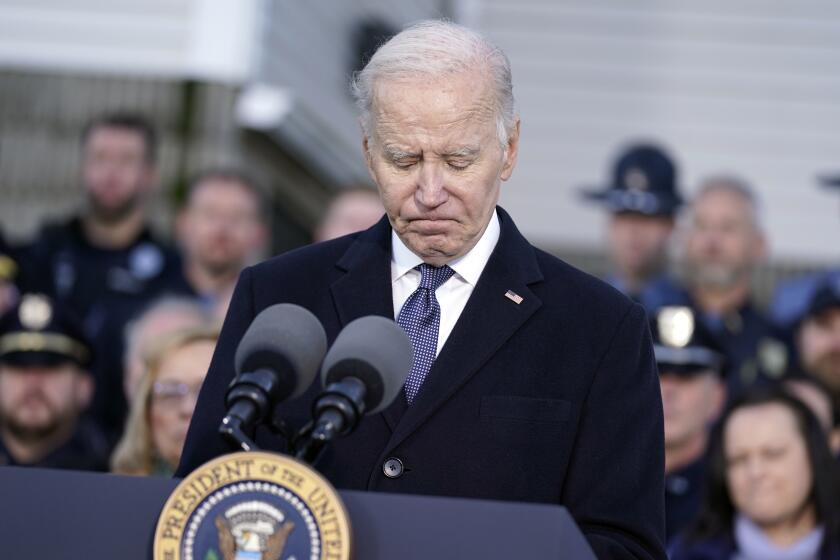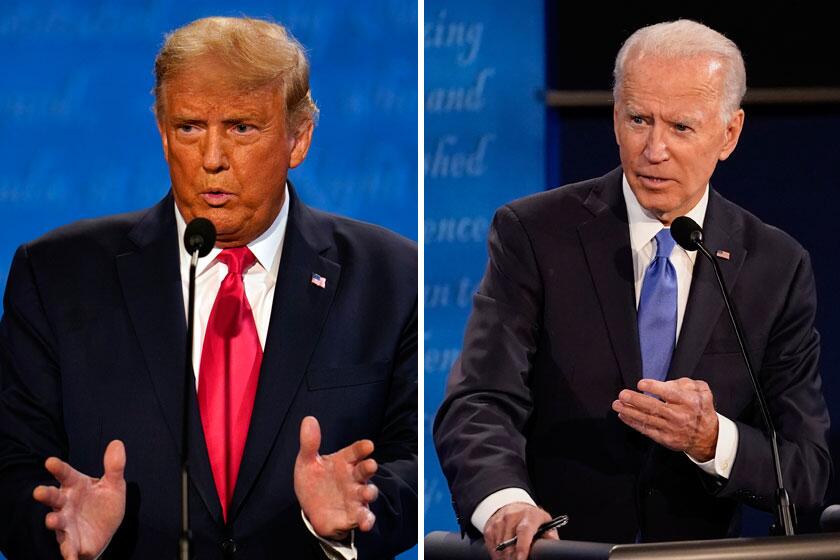Overwhelmed? Confused? Here’s what to make of all those presidential polls

- Share via
Early this week the New York Times released polling from a half-dozen political battleground states, and you might have thought Moses himself had descended Mt. Sinai with a commandment: Thus shall be decided the 2024 presidential race.
The findings weren’t good for the Democratic incumbent.
President Biden trails the serially indicted Donald Trump in five of six key states, according to the survey, and was barely ahead in the sixth.
Right on schedule, a Democratic freakout ensued, just as predictable as Sunday’s move from daylight saving to local standard time. Democrats are by nature worriers, and the polling offered ample reason for partisan stomachs to churn.
A new Los Angeles Times survey, conducted with the UC Berkeley Institute for Governmental Studies, will only add to the angst. It shows for the first time in his presidency that a majority of California voters disapprove of Biden’s job performance.
The polls make clear the current White House occupant — 80, and very much looking his age — is quite vulnerable as he bids next year for a second term. But that’s news to very few sentient people.
The polls tell us precious little about how the 2024 presidential campaign will turn out, which everybody would love to know.
You can quibble with various aspects of the polling. Jon Ralston, Nevada’s über-expert on all things political, offered a convincing explanation of why it was quite unlikely Trump was ahead by 11 percentage points in that highly competitive state, as the New York Times has suggested.
Barabak: How labor and a wily senator turned Nevada blue — and redrew the nation’s presidential map
The late Sen. Harry Reid’s clout and fundraising muscle made Nevada’s Democratic Party a juggernaut. In transforming the state, he recast the race for the White House.
But picking those nits is less important than appreciating a larger truth. Polls cannot divine the future and should not be treated as gospel truth.
Forecasting a presidential election a year out is like predicting the weather on Nov. 5, 2024. It’s possible to make some broad assumptions. (It will be cooler than it was in, say, July, and might rain or snow, depending on the locale.) But good luck nailing the exact temperature.
Whit Ayres, who has spent decades polling and strategizing for Republican candidates, described the Democratic ticket of Biden and Vice President Kamala Harris as the weakest since that of George McGovern and Sargent Shriver, who were shellacked by President Nixon in 1972.
But Ayres is not convinced Republicans will win the White House.
“There’s a host of events that are going to happen between now and November 2024 that could change the outcome, or at least affect the outcome, of the election,” Ayres said.
He’s not even certain that Biden and Trump will be their respective party nominees, though it seems more likely than not.
“There are a lot of people who are making flat statements about what’s going to happen ... that might turn out to be right but could just as likely turn out to be wrong,” Ayres said, “because they’re affected by events that haven’t happened yet.”
It’s often said that a poll is a snapshot — that is, a depiction of where a campaign stands at a particular moment in time.
But a more apt description may be an oil painting, which requires a great many decisions about how a portrait is rendered.
Arizona, once red as a desert sunset, is now a key presidential battleground. Was Biden’s win in the Grand Canyon State a fluke, or a sign of lasting change?
Pollsters — and we’re talking about the conscientious ones here — put a good deal of time and effort into figuring out how best to model their voter samples. That means once they finish interviewing respondents they weight the result to make sure it includes the correct share of men and women, young and old, and other groups, based on census data.
Then pollsters might further adjust those results to reflect what percentage of each group they believe will turn out for a given election. (Sometimes results are broken down by registered voters versus those considered likely to cast a ballot.)
How questions are asked is of vital import. Neutral phrasing is crucial, as any biases — “Knowing Candidate X worships Satan and hates small children, would you vote for him?” — can badly skew the results.
There’s a science to it. But the process also requires a certain amount of educated guesswork.
A UC Berkeley-L.A. Times poll shows approval of President Biden has dropped among key voter groups. In solidly Democratic California, he still tops Donald Trump.
Courtney Kennedy oversees methodology and computation for the Pew Research Center, which conducts in-depth surveys. The center does top-notch work, focusing on broader trends and attitudes, not the usual horse-race stuff.
Kennedy lamented the proliferation of shoddy research that grabs so much undeserved attention. (She was not speaking of the New York Times, which has been conducting reputable surveys for decades.)
“There’s no barriers to being a pollster anymore,” Kennedy said. “It used to be you had to have a brick-and-mortar shop and professional interviewers. Now anybody with a few thousand dollars could go to 100 different websites and, quote-unquote, ‘do a national poll.’ And so people do.”
Kennedy offered some tips to help the average person be a better, more-informed consumer of political polling.
For starters, she suggests taking the margin of error — the variance between what a poll finds and what the result might have been if every single person in the survey’s universe had been interviewed — and doubling it.
Put simply, that means there is a lot less precision to a poll than widely believed. If candidate A gets 50% and Candidate B gets 45%, and the stated margin of error is 3%, consider the race essentially tied. (Which is not as attention-grabbing, but sorry.)
Despite criminal charges for Trump and a growing economy under Biden, voters have short memories. But polls are a snapshot of how things appear now, not a forecast of how they will appear on election day.
Other things to look for: Is the poll conducted by a political party, a candidate or a group pushing an agenda? Beware.
Is the sample size under 500 interviews? Forget it. That’s not a meaningful survey.
How long was the poll in the field interviewing voters? A longer time frame means a better chance of drawing a representative sample.
Is the poll conducted in English only? That’s pointless in places like California, Nevada, Florida or just about anywhere with a meaningful immigrant population.
Is the pollster willing to show his or her work, revealing how many interviews were conducted over what period of time and in which languages? Transparency is key.
“If you see a poll and there’s no discussion about how they weighted on party or past vote or anything, that’s very likely to come up with suspicious results,” Kennedy said.
After 2016 and 2020 misses on Trump, Clinton and Biden, political pollsters are seeking ways to reach more voters and better weight results.
Of course, there’s a simpler solution: Ignore those who’s-up-and-who’s down polls.
Read a book. Take a walk. Eat some fiber.
If you’re really concerned about the direction of the country, your state or your community, go to work for the candidate or candidates you’d like to see elected. Or run for office yourself.
But don’t believe there’s some magic way a poll can foretell the future.
There’s a cliche — trotted out mostly by losing candidates in the final throes of their campaign — that the poll that matters most is the one on election day.
It may be hackneyed, but there’s a lot of truth to that.
More to Read
Get the latest from Mark Z. Barabak
Focusing on politics out West, from the Golden Gate to the U.S. Capitol.
You may occasionally receive promotional content from the Los Angeles Times.















